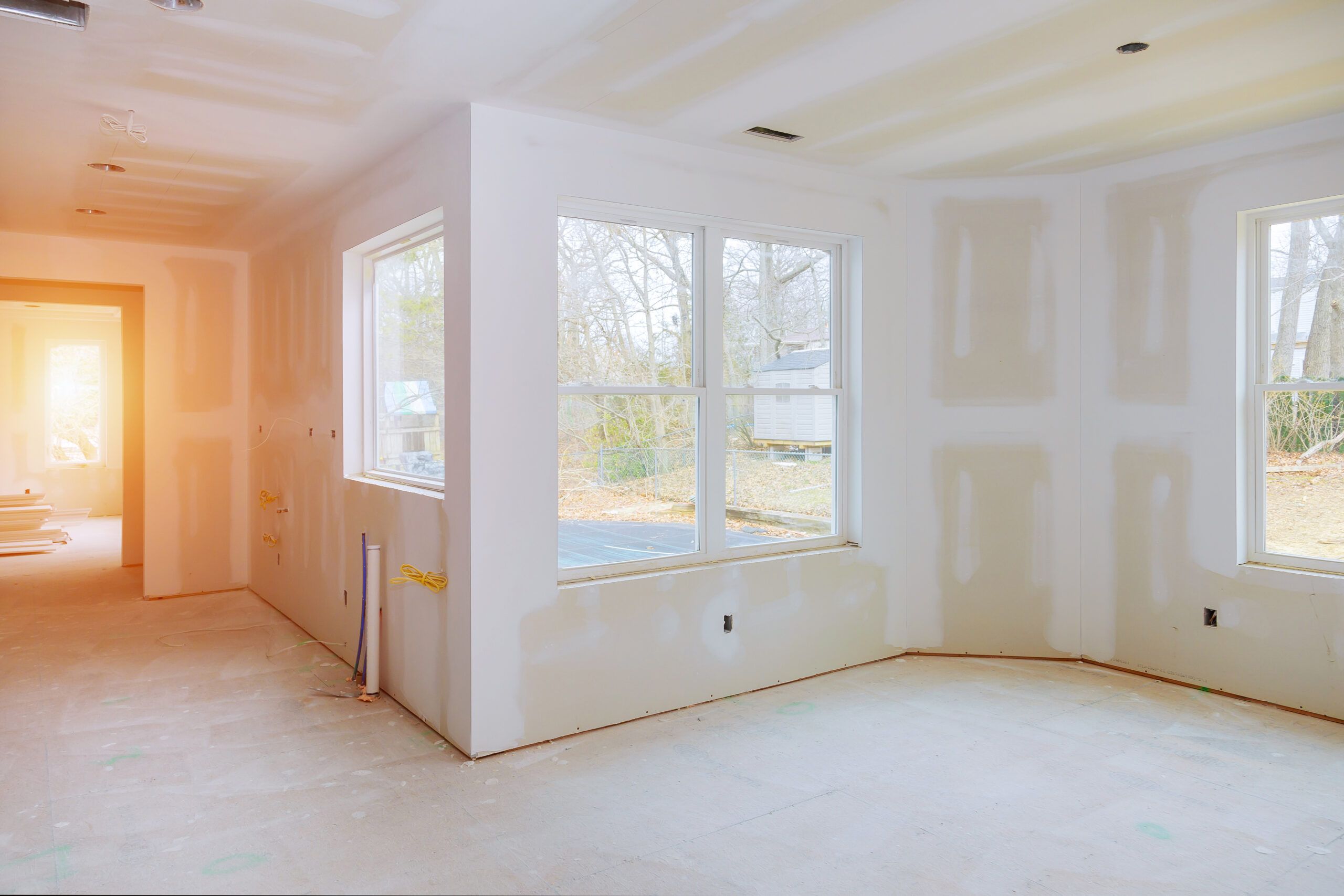Project details
Skill
Cost
Estimated Time
While hanging drywall requires some muscle, finishing it demands finesse and patience. The goal is to make the joints between drywall panels disappear, resulting in perfectly smooth walls and ceilings. This process involves applying joint compound (also known as “mud”), embedding tape, and sanding to create a flawless surface. With the proper techniques and tools, even beginners can achieve professional-looking results.
Let’s dive into the step-by-step process of how to finish drywall, from preparation to the final touches.
Drywall Finishing Basics
Drywall finishing involves concealing the seams and fasteners used in hanging drywall, also known as gypsum. You’ll need to apply joint compound, embed tape, and sand to create a smooth, uniform surface ready for painting or wallpapering.
The process isn’t complicated, but it requires attention to detail and a practiced hand. The key skills involved are properly bedding the tape and feathering out the compound to an imperceptible edge. As Paul Landry of P. L. Drywall in Waltham, Massachusetts, notes, “First time out, you’ll probably get more ‘mud’ on the floor and your clothes than you do on the wall. ” However, even beginners can get excellent results with patience and the right techniques.
Essential Tools and Materials for Drywall Finishing
You’ll need specific tools and materials to finish drywall successfully. Before you begin, make sure you have the following items.
Drywall Knives and Taping Tools
The primary tools for finishing drywall are putty knives. You’ll need at least two sizes: a 5-inch knife for taping and a 10-inch knife for feathering and applying wider coats. A taping knife or banjo can make taping easier.
Joint Compound and Tape
Joint compound, or “mud,” is ideal for filling seams and covering fasteners. For most projects, you’ll want a premixed all-purpose joint compound.
You’ll also need drywall tape, which comes in paper or mesh varieties. Paper tape is generally preferable due to its strength and ability to create the smoothest finish.
Drywall Sanding Equipment
You’ll need a swivel-head pole sander with medium and fine-grit sandpaper, as well as a sanding block for corners and tight spots. Also, be sure to pick up a dust mask and safety glasses. You don’t want to get drywall dust in your eyes or lungs.
Preparing the Work Area to Finish Drywall
Like painting, drywall finish can make a serious mess in short order. Before you start applying mud or laying drywall, we always recommend properly preparing your work area—a couple of drop cloths will save you a tremendous amount of time and headache down the road.
Cleaning and Inspecting Drywall Surfaces
Start by thoroughly inspecting the hung drywall. Look for any screwheads poking above the surface and drive them in until they’re slightly recessed. Remove any loose or torn paper, especially from corners and cut edges—this prevents scrap material from ending up in the compound.
Setting Up Your Workspace
Organize your tools and materials for easy access. If you’re finishing a drywall ceiling, set up a stable work platform. Cover the floor with drop cloths to protect it from compound drips and sanding dust. Ensure the room is well-ventilated and cool; stable temperatures are good for keeping your work bearable and important for consistent drying times.
The Five Levels of Drywall Finishing
Drywall finishing is typically categorized into five levels, each representing a different degree of smoothness and preparation. Not all levels are appropriate for every job, and you won’t want to waste the time, energy, and money of a higher level of work when a lower level will do. For example, a Level 2 finish is more than adequate for a garage, whereas Levels 3 and up would be overkill.
Level 0 to Level 2 Finishing
Level 0 involves no taping, finishing, or accessories. It’s common in temporary construction or when the final decoration has yet to be determined.
Level 1 includes taping the joints and interior angles with a thin layer of joint compound. This level is typical for non-accessible areas above ceilings or other concealed areas.
Level 2 builds on Level 1 by adding another thin coat of joint compound over the tape and fasteners. This level is standard for garages, warehouse storage areas, or other areas where appearance is not a primary concern.
Level 3 to Level 5 Finishing
Level 3 involves applying a second coat of joint compound over all joints and fasteners. This level is common when preparing the surface for a textured finish or heavy-grade wall covering.
Level 4 is the standard for most residential and commercial spaces. It includes a third coat of compound and sanding for a smooth surface suitable for most paints and light textures.
Level 5, the highest quality finish, involves applying a thin skim coat of joint compound over the entire surface. This level is ideal for areas with severe lighting conditions or when preparing the surface for glossy paint.
Step-By-Step Guide To Finishing Drywall
Applying the First Coat of Joint Compound
Begin by mixing your joint compound if necessary. If there’s water on top of the premixed compound, use a mixing paddle attached to a drill to blend it until smooth.
Using a 5-inch knife, fill your mud box halfway with compound. Load the edge of the knife blade with about 2 inches of the compound and start in one corner of the room. Force the compound into the joints between sheets, filling them in completely. Then, holding the knife at a 25-degree angle to the surface, smooth out the compound in a single pass. Fill screw holes with a swipe of a compound-loaded knife.
This first coat sets the foundation for a smooth finish.
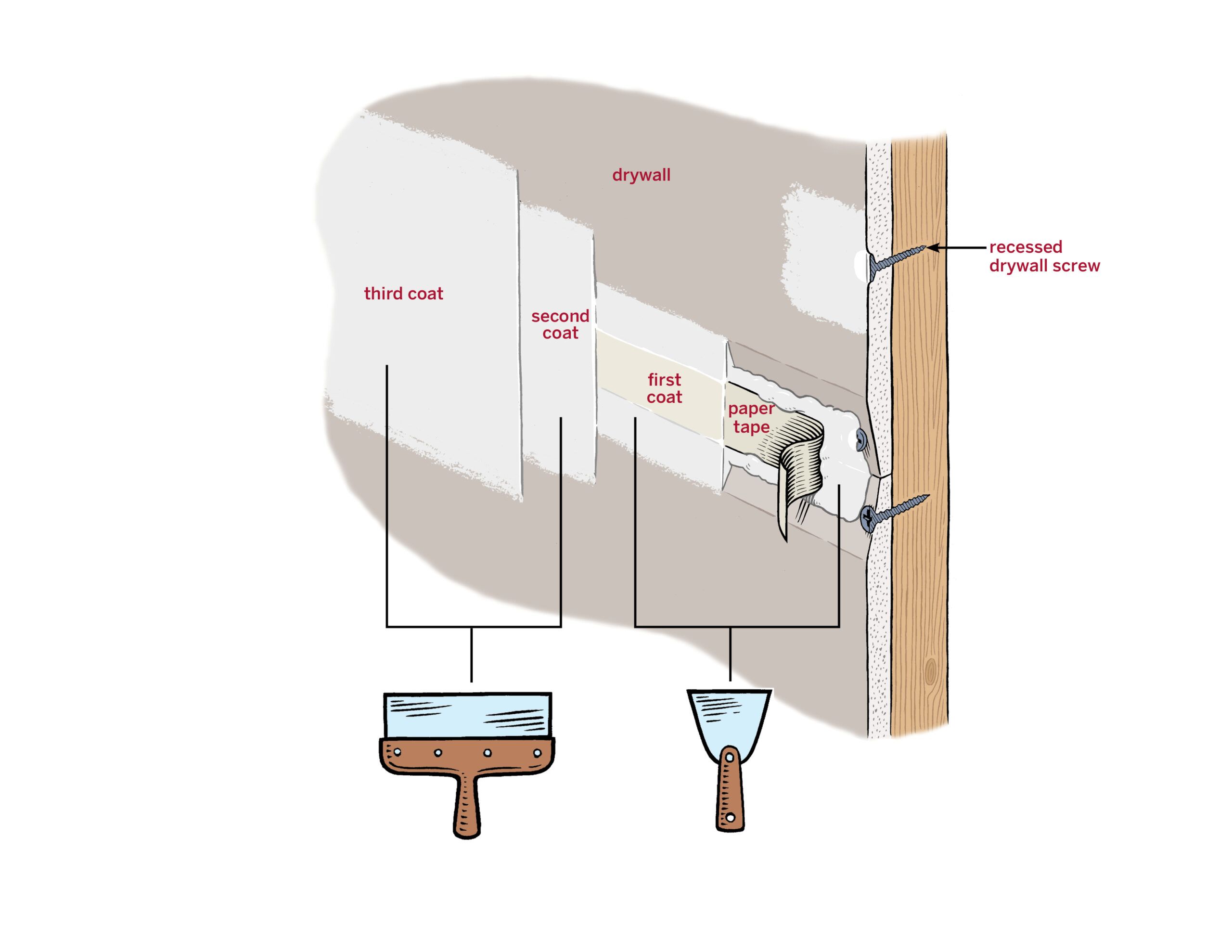
Taping Drywall Seams
After applying the first coat of compound, it’s time to embed the tape.
Unroll about 3 feet of tape and center it over the seam. Gently press it into the fresh compound with your fingers. Continue unrolling and bedding the tape along the entire joint. Tear the tape at the end of the joint by placing the knife edge perpendicular to the tape face.
To smooth the tape, start halfway along the joint and hold the 5-inch knife against the tape at a 25-degree angle to the wall. Pull the knife to one end of the joint in a single stroke, smoothing the tape and pressing it firmly into the compound. Return to the starting point and repeat in the other direction.
This technique prevents the tape from pulling off the wall.

Covering Screwheads and Corner Beads
Next, you’ll need to cover screwheads and corner beads.
For screwheads, apply a thin layer of compound over each one, ensuring they’re completely covered.
For corner beads, make sure they’re securely fastened every 10 inches. Apply compound to both sides of the bead, then smooth it out with your knife, holding the blade against the drywall and the bead simultaneously.
This process helps create crisp, clean corners that look professional when painted.
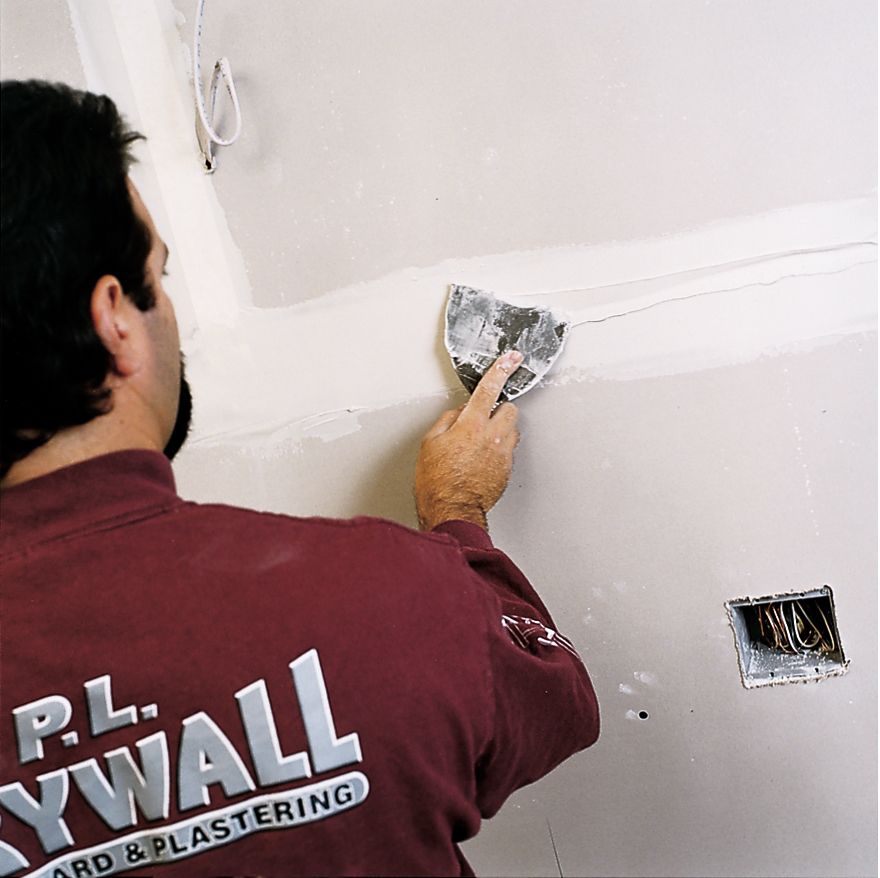
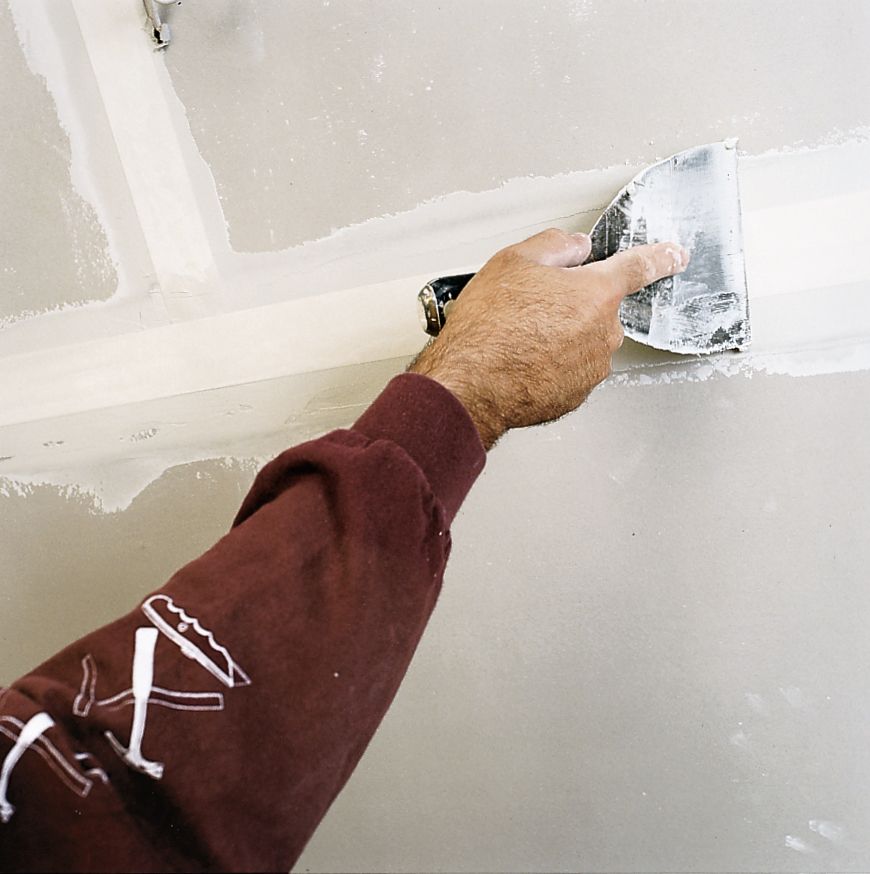
Drywall Sanding Techniques for Smooth Walls
Sanding requires patience, attention to detail, and the right choice of sandpaper to avoid damaging the work you’ve already done. It helps keep the texture of your drywall consistent and free from blemishes that may mar the paint job.
Using a Pole Sander
A pole sander is ideal for large areas and can help you maintain consistent pressure across the surface.
Start with a medium-grit sandpaper and work your way to finer grits for the smoothest finish. Apply gentle, even pressure and sand only enough to smooth rough areas. Be careful not to sand down into the paper tape, as this can damage your work and require repairs.

Hand Sanding Difficult Areas
Hand sanding is best for corners, edges, and other hard-to-reach areas.
Use a sanding block or sponge with fine-grit sandpaper. Take special care when working corners and edges to avoid damaging the drywall paper. Feel for rough areas as you go and sand as needed. Remember, the goal is to create a smooth transition between the joint compound and the drywall surface, not to remove all of the compound.
Applying Second and Third Coats to Drywall
After the first coat is dry and sanded, it’s time to apply additional coats for a seamless finish.
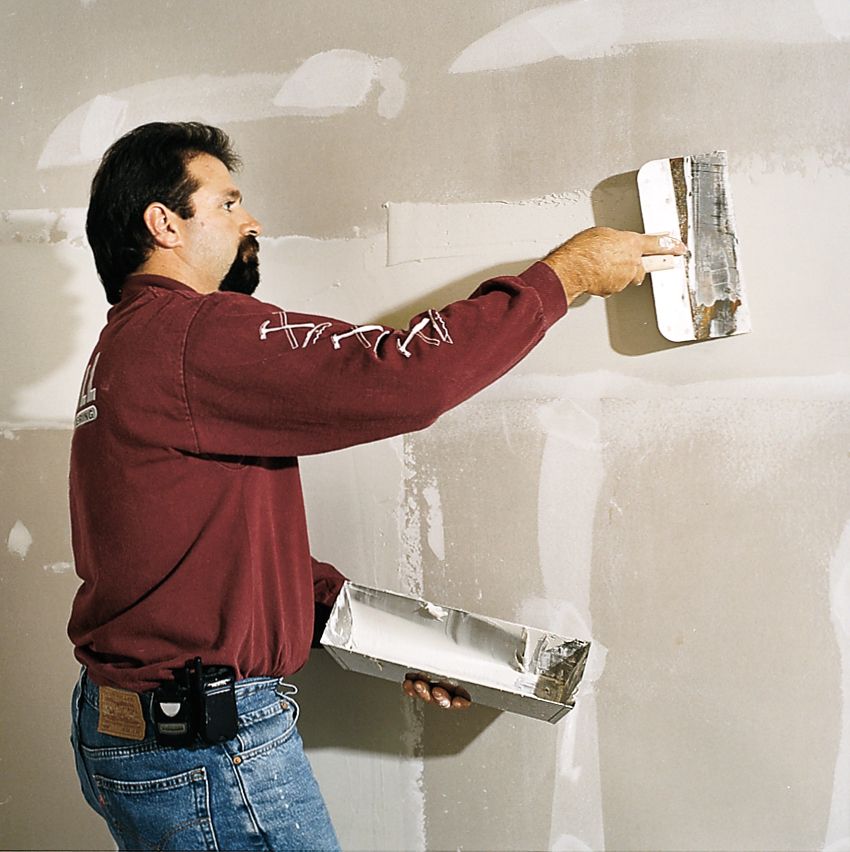
Feathering Techniques for Seamless Finish
When applying the second and third coats, use a wider knife (10 inches or more) to “feather” the edges of the compound. This technique involves gradually thinning out the edges of the compound so that it blends seamlessly with the surrounding drywall.
Start in the center of the joint and work outward, applying less pressure as you move away from the center. This technique creates a gradual transition that will be virtually invisible once painted.
Drying Time Between Coats
Our experts generally recommend waiting at least 24 hours between coats, but this can vary depending on humidity and temperature. Check that the compound is uniformly white, indicating it’s dry, with wet areas appearing darker. Rushing the process can lead to shrinkage and cracking, so patience is key. Use this time to patch any holes in the drywall you missed during the initial inspection.
Finishing Drywall Inside and Outside Corners
The techniques for inside and outside corners differ slightly, but both help create a polished finish.
Taping Inside Corners
For inside corners, start by applying compound to both sides of the corner using your 5-inch knife.
Cut a piece of tape the full length of the corner and crease it half lengthwise. Gently push the creased tape into the corner with your knife.
Starting in the middle, draw the knife along one side of the corner, smoothing the tape and squeezing out excess mud. Repeat on the other side, then smooth back to the starting point, creating a crisp, clean inside corner.
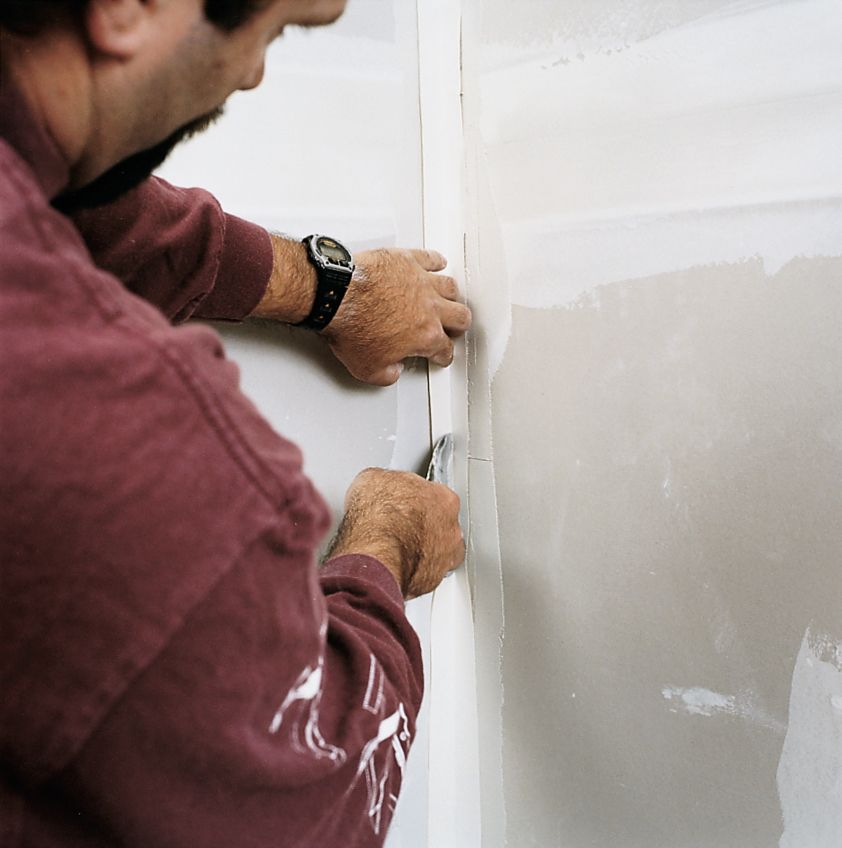
Installing and Finishing Corner Beads
Outside corners require corner beads for protection and a crisp edge.
Nail the metal corner bead every 10 inches. Using your 5-inch knife, apply the compound to both sides of the bead. Then, holding the blade against the drywall and the bead simultaneously, run the knife down the corner, smoothing the compound in a single stroke. Repeat on the other side.
This process creates a durable, sharp outside corner capable of withstanding wear and tear.
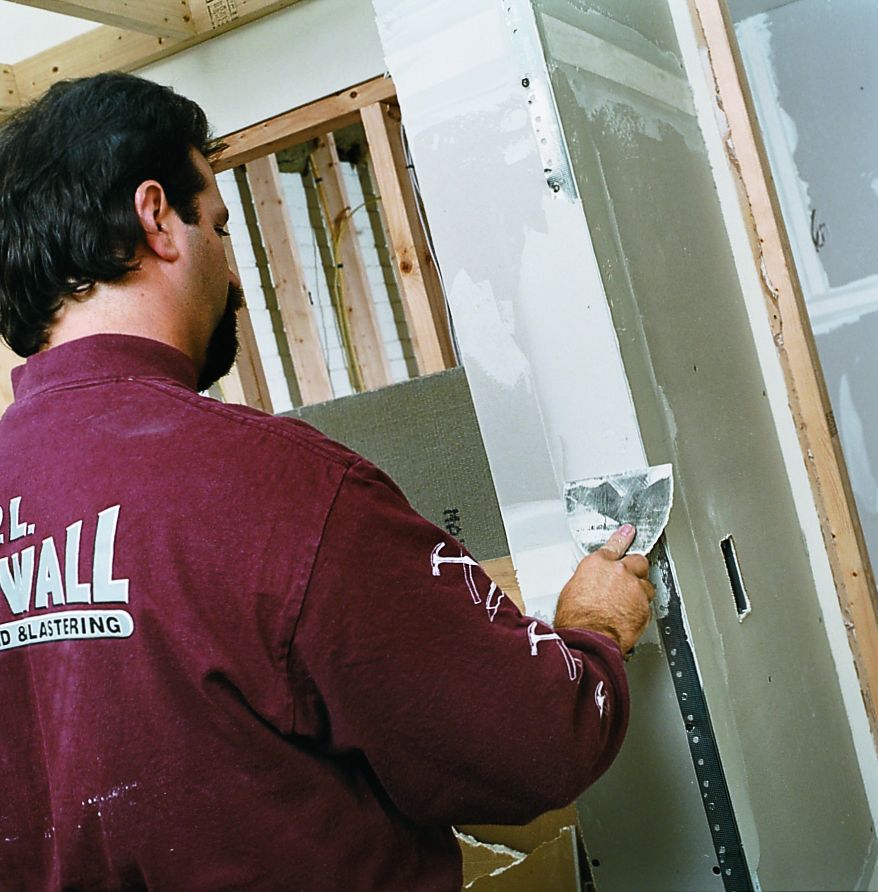
Tips for Achieving a Professional-Quality Drywall Finish
Consider these expert tips and techniques to elevate your drywall finishing from amateur to professional quality.
Avoiding Common Mistakes
One common mistake is applying too much compound, which leads to excessive sanding and potential damage to the drywall paper. Instead, apply thin, even coats and build up gradually.
Another error is rushing the drying process. Always allow each coat to dry completely before sanding or applying the next coat.
Lastly, avoid over-sanding, which can damage the paper tape or create depressions in the surface.
Tricks of the Trade
Professional finishers use a “hot mud” technique for faster drying times. The method involves using a setting-type compound for the first coat that dries through a chemical reaction rather than evaporation.
Another pro tip is to use a damp sponge instead of sandpaper for final smoothing, which can create less dust.
Finally, consider using a halogen work light held at an angle to the wall to spot imperfections more easily.
Priming and Painting Finished Drywall
Once you’ve completed the finishing process and the final sanding, it’s time to prepare the surface for paint or wallpaper.
Start by wiping down all surfaces with a damp cloth to remove any sanding dust. Allow the walls to dry completely, then apply a coat of drywall primer. This step seals the porous surface of the joint compound and provides a uniform base for paint.
Choose a primer specifically designed for new drywall to help hide minor imperfections and aid in paint absorption. After the primer has dried, your walls are ready for the final coat of paint or wallpaper application.
Troubleshooting Drywall Finishing Issues
Even with careful work, you may encounter some issues during the drywall finishing process. Knowing how to address these problems can save time and create a professional-looking wall.
Dealing with Bubbles and Blisters
Bubbles or blisters in the tape can occur if air gets trapped underneath. To fix this, use a utility knife to cut out the affected area, then reapply fresh compound and tape. Be sure to press out any air bubbles when embedding the tape. For small blisters in the compound, sand them down and apply a thin coat of compound to smooth the area.
Fixing Cracks and Imperfections
If you notice cracks forming in the dried compound, it’s usually due to the compound drying too quickly or being applied too thickly. To fix this, sand down the area, apply a thin coat of compound, and re-tape if necessary.
For other imperfections like dents or gouges, fill them with compound, allow them to dry, and sand smooth. Remember, multiple thin coats are better than one thick coat when fixing imperfections.
Our Conclusion
Finishing drywall is a skill that improves with practice, but even beginners can achieve excellent results by following these steps and techniques. We recommend working patiently, applying thin coats, and allowing proper drying time between each step. Remember that the goal is to create a smooth, seamless surface that will look flawless once painted.
While the process may seem time-consuming, the results are worth the effort. A well-finished drywall job can dramatically improve the look of any room, providing a clean canvas for paint or wallpaper. If you’re tackling a large project or feel unsure about your skills, don’t hesitate to consult with or hire a professional.
Tools
 Drill/driver
Drill/driver Drywall taping tool
Drywall taping tool Swivel-head pole sander
Swivel-head pole sander Sanding block
Sanding block Mortar box
Mortar box Drywall knives – 5- and 10-in.
Drywall knives – 5- and 10-in. Mallet
Mallet Corner clincher
Corner clincher
